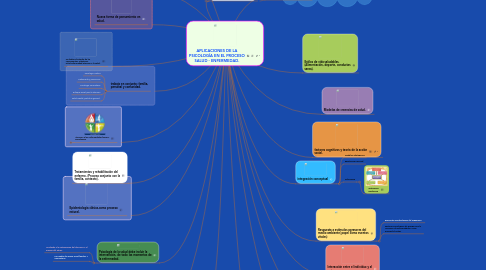
1. trabajo en conjunto: familia, personal y comunidad.
1.1. Psicologia Médica
1.2. Tratamiento y prevención
1.3. Psicologia Comunitaria
1.4. Enfoque social para la atención
1.5. Salud mental y salud en general.
2. Atención a las enfermedades fisicas y psicológicas
2.1. Market Analysis
2.1.1. Situational Analysis / Drivers
2.1.1.1. What is driving us to do this?
2.1.1.2. SWOT Analysis
2.1.1.2.1. Strengths
2.1.1.2.2. Weaknesses
2.1.1.2.3. Opportunities
2.1.1.2.4. Threats
2.1.1.3. Customer Findings - What have we learned from customers?
2.1.2. Competitive Analysis
2.1.2.1. Do we have competitors and threats in these target markets with the proposed offerings?
2.1.2.2. What are our competitors doing and how are they positioning?
2.1.2.3. How do we position against each competitor?
2.1.3. Target Customer(s)
2.1.3.1. Buyer Profile
2.1.3.1.1. Title
2.1.3.1.2. Industry
2.1.3.1.3. Geography
2.1.3.1.4. Business Size
2.1.3.2. Influencer Profile
2.1.3.3. User Profile
2.1.3.4. What do customers want and need?
2.1.3.5. What business problems do each of these customers have?
2.1.4. Customer Segmentation
2.1.4.1. Which customers or sets of customers do we sell to?
2.1.4.2. What are the target market segments that we want to go after?
2.1.4.3. What are the distinct problems for each segment of the market?
2.1.5. Total Available Market
2.1.5.1. New Prospects
2.1.5.1.1. How much of each target segment have we penetrated?
2.1.5.1.2. How much opportunity is available in each target segment?
2.1.5.2. Existing Customers
2.1.5.2.1. Can we up-sell existing customers?
2.2. Offer Definition
2.2.1. Service Offer
2.2.1.1. What are we selling?
2.2.1.2. Product Definition
2.2.1.3. Pricing
2.2.1.4. Packaging
2.2.1.5. Positioning
2.2.2. Value Proposition
2.2.2.1. What is the Value Proposition to the Customer?
2.2.2.2. What pain are we solving?
2.3. Financial Analysis
2.3.1. Revenue Forecasts
2.3.1.1. Revenue and P&L Forecast (5 Years)
2.3.1.2. Revenue should be split out quarterly
2.3.2. Cost Analysis
2.3.2.1. Should include a description of the costs in entering this business and profitability analysis
2.3.3. Profitability Analysis
2.3.3.1. P&L for the offer to include gross margin, net income and break even analysis.
2.4. Sales Execution Plan
2.4.1. Sales Strategy
2.4.1.1. Direct Sales Strategy
2.4.1.2. Inside Sales Strategy
2.4.1.3. Channel Sales Strategy
2.4.2. Partner Strategy
2.4.2.1. Channel Strategy
2.4.2.1.1. What 3rd party channels should we consider for reselling this service?
2.4.2.2. Technology Partnerships
2.4.2.2.1. What technology vendors (if any) do we need to work with to execute on this plan?
2.4.2.3. Solutions Partners
2.5. Go-To-Market Strategy
2.5.1. Positioning & Messaging
2.5.1.1. What is the key messaging and positioning for the service offer? (Pain, alternatives, solution)
2.5.1.2. How do we communicate internally?
2.5.1.3. How do we communicate externally?
2.5.2. Promotion Strategy
2.5.2.1. Marketing Programs (Installed base versus new prospects)
2.5.2.2. Advertising (Publications, etc.)
2.5.2.3. Analyst Relations (Target Analysts)
2.5.2.4. Public Relations
2.5.2.5. Events (Trade shows, SEO/SEA, Seminars)
2.5.2.6. Webinars
2.5.3. Demand Generation & Lead Qualification
2.5.3.1. How do we generate and qualify new leads for the target offer?
2.5.3.2. Prospect Lists
2.5.3.3. Key Questions to Ask
2.5.3.4. Sales Collateral
2.5.3.5. Presentations
2.5.3.6. Data Sheets
2.5.3.7. White Papers
2.5.3.8. ROI Tools
2.5.3.9. Other Sales Tools (web site, etc.)
2.6. Measure and Improve
2.6.1. Numbers, budget, waterfall, break-even (cost>leads>trials>deals)
2.6.2. Sales Programs
2.6.3. Accelerated Learning Strategy, Controls, Metrics
2.6.4. Include feedback loops
2.6.5. Include financial metrics (definition of success)
2.6.6. Pipeline reports, etc…
2.7. Other Considerations
2.7.1. M&A?
2.7.2. Risk Analysis & Mitigation
3. La psicología clínica en el proceso de salud, es el mas viejo y comienza a finales del siglo XIX.
4. Comprende cada vez mas las variables sociales y personales.
5. Periodo de prepatogenesis y patógenesis.
5.1. Desarrollo de la enfermedad
6. Se dedica al estudio de los componentes subjetivos- salud-enfermedad-atención a la salud.
7. Nueva forma de pensamiento en salud.
8. Epidemiologia clásica-como proceso natural.
9. .
10. Tratamientos y rehabilitación del enfermo. (Proceso conjunto con la familia, contexto).
11. Prevención: Conductas preventivas
12. variables psicosociales mediatizan el proceso de búsqueda de ayuda inmediata.
13. Psicología de la salud debe incluir la intervención, de todo los momentos de la enfermedad.
13.1. Ayudando a la optimizacion del descanso y el manejo del estres.
13.2. Por medio de apoyo social familiar y comunitario
14. REFERENCIAS BIBLIOGRÁFICAS: Libertad, M,. (2003). Aplicaciones de la psicología en el proceso salud enfermedad. Rev. Cubana salud pública. Vol.23 N°3. Pp 275-281
15. REALIZADO POR: Angie Natalia Candelo Parra Código: 1135093
16. Modelo hipotetico y progresivo
16.1. Practica reguladora de:
16.2. Ejercicios fisicos,
16.3. Sustancias toxicas
16.4. Nutrición adecuada
16.5. Practicas adecuadas de higiene
17. Modelos de creencias de salud.
18. factores cognitivos y teoría de la acción social.
19. integración conceptual
19.1. Modelos Salutogenos
19.2. Resistencia Personal
19.3. Coherencia
19.3.1. Optimismo Resiliencia
20. Factores de riesgo: Estrés, enfermedades cronicas, spa, alcoholismo, tabaquismo
20.1. Ansiedad
20.2. Depresión
21. Respuesta a estímulos agresores del medio ambiente( papel como eventos vitales)
21.1. Respuesta Psicobiologica del organismo.
21.2. Factores Psicológicos de Riesgo para la Aparición de Enfermedades: como principal el Estrés
22. Interacción entre el individuo y el entorno.
23. Psiconeuroinmunologia
23.1. Responsable de Funciones Reguladoras
23.2. variables emocionales
23.2.1. sistema nervioso
23.2.1.1. sistema endocrino
